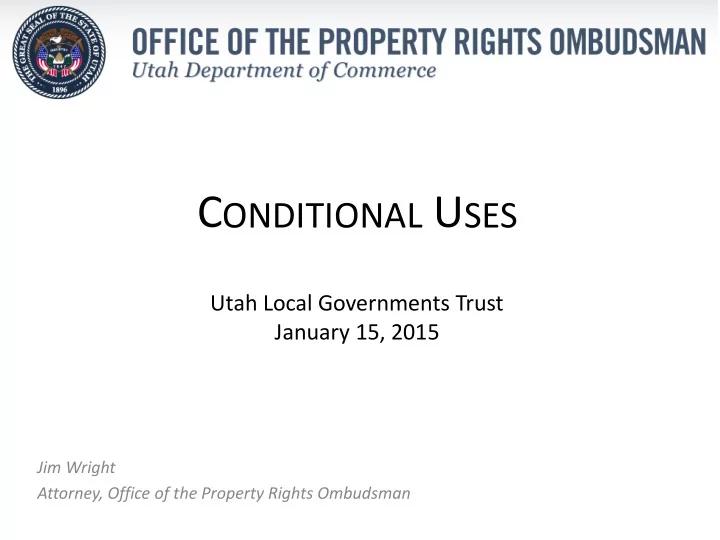

C ONDITIONAL U SES Utah Local Governments Trust January 15, 2015 Jim Wright Attorney, Office of the Property Rights Ombudsman
I NTRODUCTION • Zoning overview • Conditional use basics • Case studies
Z ONING O VERVIEW • Zoning: The regulation of land uses and structures in specific geographic areas within a jurisdiction • Village of Euclid v. Ambler Realty Co ., 272 U.S. 365 (1926) – Zoning made industrial development difficult – Supreme Court upheld zoning law – Found rational basis for law
• Utah statutory law provisions – LUDMA (UCA § 10-9a-101 and UCA § 17-27a-101) – Broad authority to pass laws (UCA § 10-9a-102) – Express authority to enact zoning ordinances (UCA § 10-9a- 501) – “A land use ordinance may include conditional uses. . . .” (UCA § 10-9a-507(1))
C ONDITIONAL U SE B ASICS • Definition: "Conditional use" means a land use that, because of its unique characteristics or potential impact on the municipality, surrounding neighbors, or adjacent land uses, may not be compatible in some areas or may be compatible only if certain conditions are required that mitigate or eliminate the detrimental impacts. (UCA § 10-9a-103(5)) • Inclusion is optional —“A land use ordinance may include conditional uses . . . that require compliance with standards set forth in an applicable ordinance.” (UCA § 10-9a-507(1) emphasis added) • Ordinance should include applicable standards (UCA § 10-9a-507(1)) • Administrative action (include evidence in the record)
• Must approve “ if reasonable conditions are proposed, or can be imposed, to mitigate the reasonably anticipated detrimental effects of the proposed use in accordance with applicable standards .” (UCA § 10-9a-507(2)(a)) • When evaluating application, need to – Identify detrimental effects – Identify reasonable conditions to mitigate detrimental effects – Ensure conditions relate to standards in an ordinance • South Salt Lake example
17.09.060 - Review standards. The land use authority shall require each conditional use applicant to address the following standards, where appropriate: A. Zoning Ordinance Compliance. The proposed conditional use shall be consistent with small area master plans, general plan and future land use map applicable to the site where the conditional use will be located. B. Use Compatibility. Reasonable conditions may be imposed to ensure optimal compatibility with the character of the site, adjacent properties, and existing development within the vicinity of the proposed site. In determining compatibility, the land use authority considers: 1. Whether access to the site can be achieved without materially degrading the service level on any streets which would serve for access; 2. Whether the proposed use would create unusual pedestrian or traffic patterns or volumes that would not be expected with a permitted use in that location, taking into consideration the orientation of streets and driveways, parking areas and sizes, hours of peak traffic, and the hours of operation at the proposed site; 3. Whether utility and public services will be adequate to support the proposed use at normal service levels without adverse impacts on adjacent uses or resources; and 4. Whether buffering or other mitigation measures will be provided to protect adjacent lands from unlawful or excessive noise, light, odor or visual impact, or from other unusual disturbances from deliveries, mechanical equipment or trash collection. C. Design Compatibility. The proposed conditional use shall be compatible with the character of the area where the use will be located, and the land use authority may impose reasonable conditions that address reasonably anticipated detrimental effects related to: 1. Size, configuration and location of the site and the proposed site plan layout; 2. Proposed site ingress and egress to existing and proposed roads and streets; 3. The adequacy, provision, relocation, or protection of public facilities and amenities, including roads and streets, culinary water, secondary water, sanitary sewer, storm drainage, flood protection, public safety and fire protection, and other utilities; (South Salt Lake Ordinances)
Must Must remember it is an administrative decision
• May deny “ if the reasonably anticipated detrimental effects of a proposed conditional use cannot be substantially mitigated by the proposal or the imposition of reasonable conditions to achieve compliance with applicable standards .” (UCA § 10-9a-507(2)(b)) • Must file appeals within 30 days of becoming final (UCA § 10-9a-801(2)(a)) • Court will uphold as long as not arbitrary, capricious or illegal (UCA § 10-9a-801(3)(a)(ii)) • It is illegal if it violates a law, statute or ordinance in effect at the time of the decision (UCA § 10-9a-801(3)(a)(ii)) • It is arbitrary and capricious if it is not supported by substantial evidence in the record (UCA § 10-9a-801(3)(c)) » Substantial evidence is sufficient evidence to convince a reasonable mind of a conclusion ( Bradley v. Payson City, 70 P.3d 47, 52 (2003))
C ASE S TUDIES • Wadsworth v. West Jordan (denial overturned) • Gun Vault Advisory Opinion (approval upheld)
O FFICE OF THE P ROPERTY R IGHTS O MBUDSMAN P.O. Box 146702 Salt Lake City, UT 84114 801-530-6391 Statewide: 1-877-882-4662 FAX 801-530-6338 propertyrights@utah.gov propertyrights.utah.gov
Recommend
More recommend